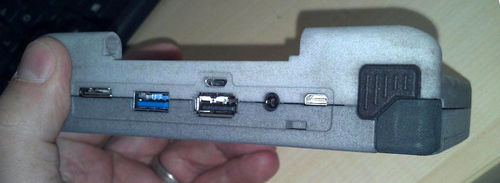USB
The Pyra has four USB ports, as detailed below.
For our purposes:
- "USB2" means "capable of Low, Full and High-speed"
- "USB3" means "capable of low, full, high and super-speed"
- "OTG" means capable of operating in either host- or slave-mode.
Full-size USB2 Port
This is a straightforward USB port as found on many desktop PCs. I can be used for keyboards, mice, USB memory sticks, network adaptors and many other things (subject to driver support)
Full-size USB2 Port with eSATA
This can be used as a simple USB2 port as above. Although this uses a blue Connector designed for USB3 Ports, it is not capable of USB3 (with the current CPU-Board). The additional pins are used for (e-)SATA Lanes for to an Adapter. See Storage for more details.
Micro-USB3 OTG Port
This can be used much like the full-size USB2 ports, but at higher speeds and with the obvious requirement for a passive adaptor when using most peripherals. It can also be used to charge the Pyra (either from another computer, or a mains adaptor) and to operate as a USB slave. The Pandora has software allowing it to operate as a USB mouse, joystick, keyboard or SD-card reader in slave mode. It is expected that similar software will be available for the Pyra.
Serial-via-micro-USB Port
This is not a general-purpose USB port (as a result of limitations of the SOC) but can be used in two ways:
- Charging the Pyra while the primary microUSB3 port is in host mode.
- Monitoring the Pyra using another computer (Serial output from the Pyra's processor, via a built-in Serial-USB translator, with the Pyra as USB slave)
Charger
The Pyra will charge from a standard microUSB cable, much in the same way as any other (non-apple) portable device made in the last few years.
Sample of potentially official charger
